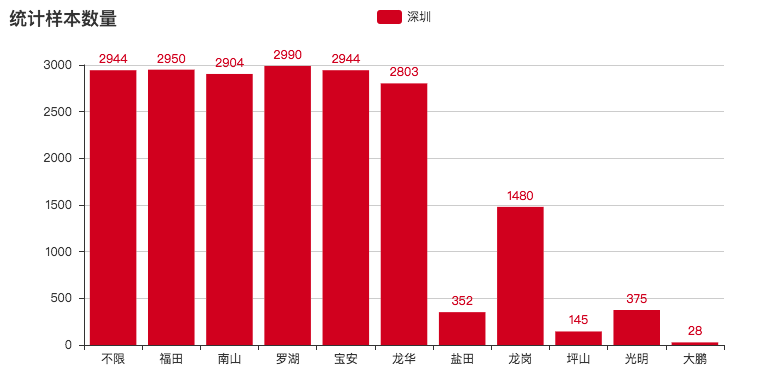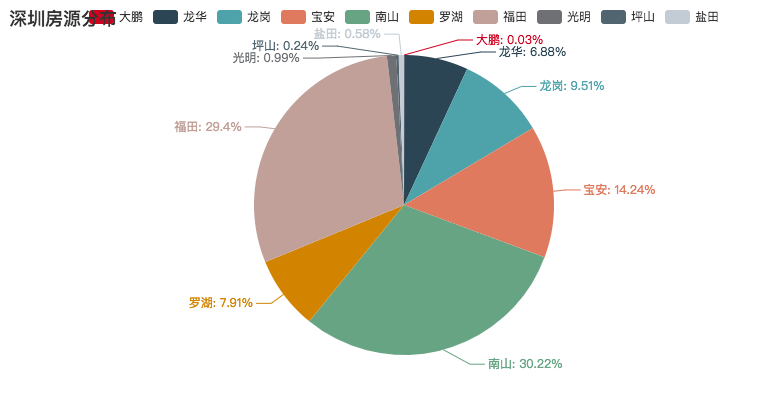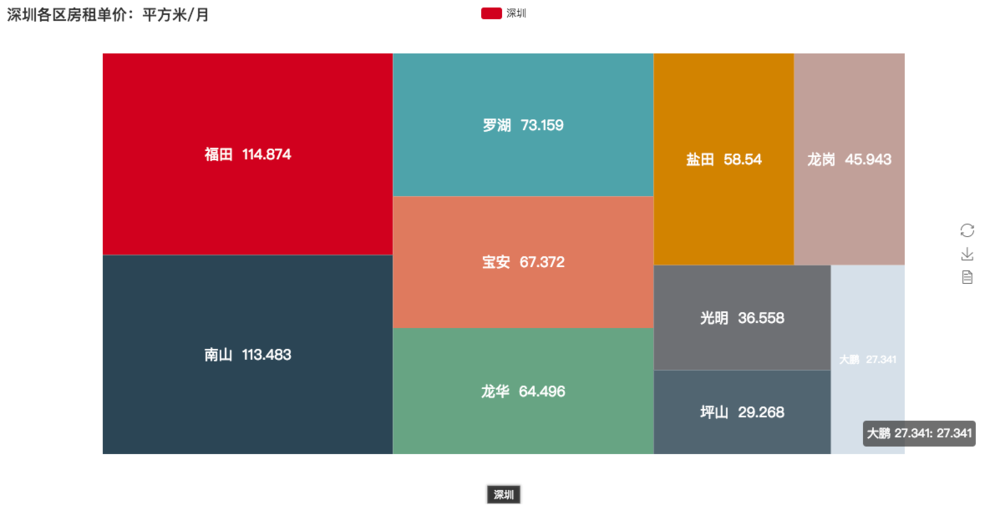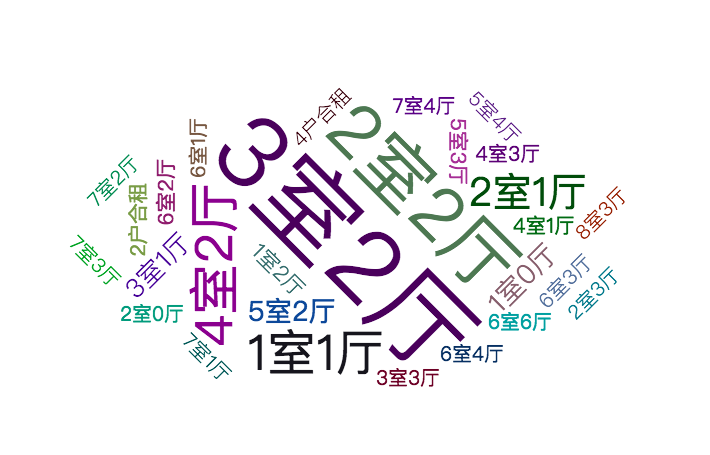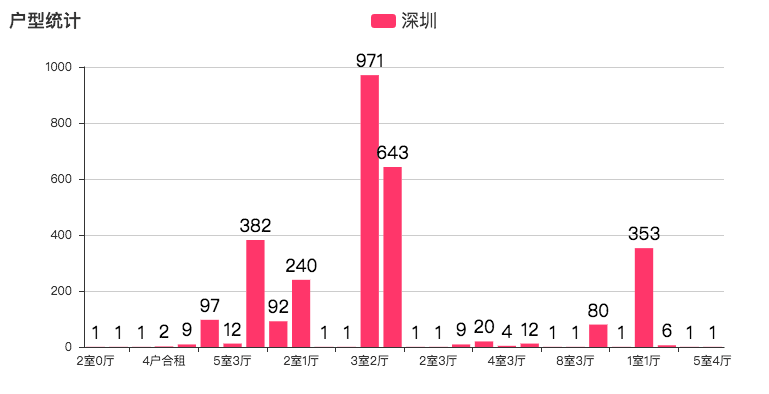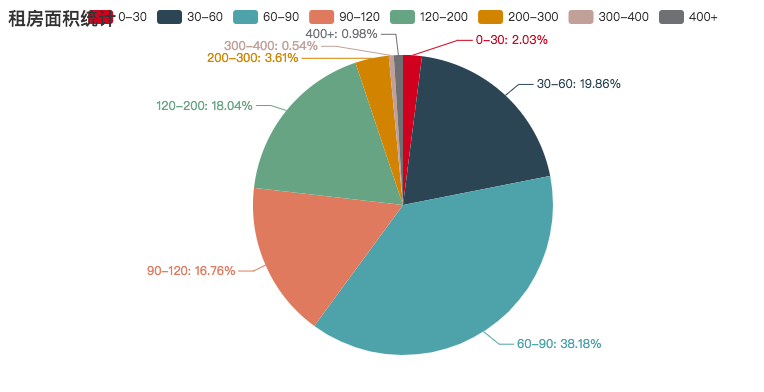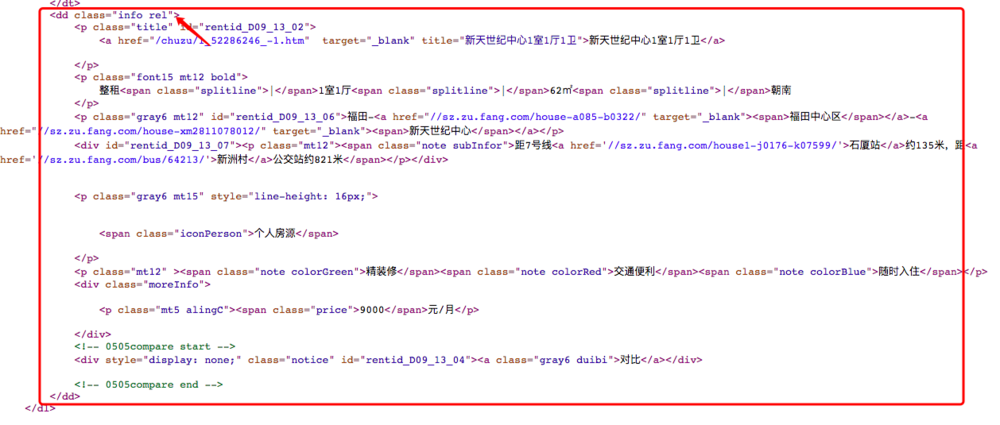概述
- 前言
- 统计结果
- 爬虫技术分析
- 爬虫代码实现
- 爬虫分析实现
- 后记
前言
最近各大一二线城市的房租都有上涨,究竟整体上涨到什么程度呢?我们也不得而知,于是乎 zone 为了一探究竟,便用 Python 爬取了房某下的深圳的租房数据,以下是本次的样本数据:
除去【不限】的数据(因为可能会与后面重叠),总数据量为 16971 ,其中后半部分地区数据量偏少,是由于该区房源确实不足。因此,此次调查也并非非常准确,权且当个娱乐项目,供大家观赏。
统计结果
我们且先看统计结果,然后再看技术分析。
深圳房源分布:(按区划分)
其中福田与南山的房源分布是最多的。但这两块地的房租可是不菲啊。
房租单价:(每月每平方米单价 -- 平均数)
即是 1 平方米 1 个月的价格。方块越大,代表价格越高。
可以看出福田与南山是独占鳌头,分别是 114.874 与 113.483 ,是其他地区的几倍。如果租个福田 20 平方的房间:
- 114.874 x 20 = 2297.48
再来个两百的水电、物业:
- 2297.48 + 200 = 2497.48
我们节俭一点来算的话,每天早餐 10 块,中午 25 块,晚饭 25 块:
- 2497.48 + 50 x 30 = 3997.48
是的,仅仅是活下来就需要 3997.48 块。
隔断时间下个馆子,每个月买些衣服,交通费,谈个女朋友,与女朋友出去逛街,妥妥滴加个 3500
- 3997.48 + 3500 = 7497.48
给爸妈一人一千:
- 7497.48 + 2000 = 9497.48
月薪一万妥妥滴,变成了月光族。
房租单价:(每日每平方米单价 -- 平均数)
- 即是 1 平方米 1 天的价格。
以前在乡下没有***的感觉,那么可以到北上广深体验一下,福田区每平方米每天需要 3.829 元。[捂脸]
户型
户型主要以 3 室 2 厅与 2 室 2 厅为主。与小伙伴抱团租房是***的选择了,不然与不认识的人一起合租,可能会发生一系列让你不舒服的事情。字体越大,代表户型数量越多。
租房面积统计
其中 30 - 90 平方米的租房占大多数,如今之计,也只能是几个小伙伴一起租房,抱团取暖了。
租房描述词云
这是爬取的租房描述,其中字体越大,标识出现的次数越多。其中【精装修】占据了很大的部分,说明长租公寓也占领了很大一部分市场。
爬虫思路
先爬取房某下深圳各个板块的数据,然后存进 MongoDB 数据库,***再进行数据分析。
数据库部分数据:
- /* 1 */
- {
- "_id" : ObjectId("5b827d5e8a4c184e63fb1325"),
- "traffic" : "距沙井电子城公交站约567米。",//交通描述
- "address" : "宝安-沙井-名豪丽城",//地址
- "price" : 3100,//价格
- "area" : 110,//面积
- "direction" : "朝南\r\n ",//朝向
- "title" : "沙井 名豪丽城精装三房 家私齐拎包住 高层朝南随时看房",//标题
- "rooms" : "3室2厅",//户型
- "region" : "宝安"//地区
- }
爬虫技术分析
- 请求库:requests
- HTML 解析:BeautifulSoup
- 词云:wordcloud
- 数据可视化:pyecharts
- 数据库:MongoDB
- 数据库连接:pymongo
爬虫代码实现
首先右键网页,查看页面源码,找出我们要爬取得部分。
源码
代码实现,由于篇幅原因只展示主要代码:(获取一个页面的数据)
- def getOnePageData(self, pageUrl, reginon="不限"):
- rent = self.getCollection(self.region)
- self.session.headers.update({
- 'User-Agent': 'Mozilla/5.0 (Macintosh; Intel Mac OS X 10_13_3) AppleWebKit/537.36 (KHTML, like Gecko) Chrome/68.0.3440.84 Safari/537.36'})
- res = self.session.get(
- pageUrl
- )
- soup = BeautifulSoup(res.text, "html.parser")
- divs = soup.find_all("dd", attrs={"class": "info rel"}) # 获取需要爬取得 div
- for div in divs:
- ps = div.find_all("p")
- try: # 捕获异常,因为页面中有些数据没有被填写完整,或者被插入了一条广告,则会没有相应的标签,所以会报错
- for index, p in enumerate(ps): # 从源码中可以看出,每一条 p 标签都有我们想要的信息,故在此遍历 p 标签,
- text = p.text.strip()
- print(text) # 输出看看是否为我们想要的信息
- print("===================================")
- # 爬取并存进 MongoDB 数据库
- roomMsg = ps[1].text.split("|")
- # rentMsg 这样处理是因为有些信息未填写完整,导致对象报空
- area = roomMsg[2].strip()[:len(roomMsg[2]) - 2]
- rentMsg = self.getRentMsg(
- ps[0].text.strip(),
- roomMsg[1].strip(),
- int(float(area)),
- int(ps[len(ps) - 1].text.strip()[:len(ps[len(ps) - 1].text.strip()) - 3]),
- ps[2].text.strip(),
- ps[3].text.strip(),
- ps[2].text.strip()[:2],
- roomMsg[3],
- )
- rent.insert(rentMsg)
- except:
- continue
数据分析实现
数据分析:
- # 求一个区的房租单价(平方米/元)
- def getAvgPrice(self, region):
- areaPinYin = self.getPinyin(region=region)
- collection = self.zfdb[areaPinYin]
- totalPrice = collection.aggregate([{'$group': {'_id': '$region', 'total_price': {'$sum': '$price'}}}])
- totalArea = collection.aggregate([{'$group': {'_id': '$region', 'total_area': {'$sum': '$area'}}}])
- totalPrice2 = list(totalPrice)[0]["total_price"]
- totalArea2 = list(totalArea)[0]["total_area"]
- return totalPrice2 / totalArea2
- # 获取各个区 每个月一平方米需要多少钱
- def getTotalAvgPrice(self):
- totalAvgPriceList = []
- totalAvgPriceDirList = []
- for index, region in enumerate(self.getAreaList()):
- avgPrice = self.getAvgPrice(region)
- totalAvgPriceList.append(round(avgPrice, 3))
- totalAvgPriceDirList.append({"value": round(avgPrice, 3), "name": region + " " + str(round(avgPrice, 3))})
- return totalAvgPriceDirList
- # 获取各个区 每一天一平方米需要多少钱
- def getTotalAvgPricePerDay(self):
- totalAvgPriceList = []
- for index, region in enumerate(self.getAreaList()):
- avgPrice = self.getAvgPrice(region)
- totalAvgPriceList.append(round(avgPrice / 30, 3))
- return (self.getAreaList(), totalAvgPriceList)
- # 获取各区统计样本数量
- def getAnalycisNum(self):
- analycisList = []
- for index, region in enumerate(self.getAreaList()):
- collection = self.zfdb[self.pinyinDir[region]]
- print(region)
- totalNum = collection.aggregate([{'$group': {'_id': '', 'total_num': {'$sum': 1}}}])
- totalNum2 = list(totalNum)[0]["total_num"]
- analycisList.append(totalNum2)
- return (self.getAreaList(), analycisList)
- # 获取各个区的房源比重
- def getAreaWeight(self):
- result = self.zfdb.rent.aggregate([{'$group': {'_id': '$region', 'weight': {'$sum': 1}}}])
- areaName = []
- areaWeight = []
- for item in result:
- if item["_id"] in self.getAreaList():
- areaWeight.append(item["weight"])
- areaName.append(item["_id"])
- print(item["_id"])
- print(item["weight"])
- # print(type(item))
- return (areaName, areaWeight)
- # 获取 title 数据,用于构建词云
- def getTitle(self):
- collection = self.zfdb["rent"]
- queryArgs = {}
- projectionFields = {'_id': False, 'title': True} # 用字典指定需要的字段
- searchRes = collection.find(queryArgs, projection=projectionFields).limit(1000)
- content = ''
- for result in searchRes:
- print(result["title"])
- content += result["title"]
- return content
- # 获取户型数据(例如:3 室 2 厅)
- def getRooms(self):
- results = self.zfdb.rent.aggregate([{'$group': {'_id': '$rooms', 'weight': {'$sum': 1}}}])
- roomList = []
- weightList = []
- for result in results:
- roomList.append(result["_id"])
- weightList.append(result["weight"])
- # print(list(result))
- return (roomList, weightList)
- # 获取租房面积
- def getAcreage(self):
- results0_30 = self.zfdb.rent.aggregate([
- {'$match': {'area': {'$gt': 0, '$lte': 30}}},
- {'$group': {'_id': '', 'count': {'$sum': 1}}}
- ])
- results30_60 = self.zfdb.rent.aggregate([
- {'$match': {'area': {'$gt': 30, '$lte': 60}}},
- {'$group': {'_id': '', 'count': {'$sum': 1}}}
- ])
- results60_90 = self.zfdb.rent.aggregate([
- {'$match': {'area': {'$gt': 60, '$lte': 90}}},
- {'$group': {'_id': '', 'count': {'$sum': 1}}}
- ])
- results90_120 = self.zfdb.rent.aggregate([
- {'$match': {'area': {'$gt': 90, '$lte': 120}}},
- {'$group': {'_id': '', 'count': {'$sum': 1}}}
- ])
- results120_200 = self.zfdb.rent.aggregate([
- {'$match': {'area': {'$gt': 120, '$lte': 200}}},
- {'$group': {'_id': '', 'count': {'$sum': 1}}}
- ])
- results200_300 = self.zfdb.rent.aggregate([
- {'$match': {'area': {'$gt': 200, '$lte': 300}}},
- {'$group': {'_id': '', 'count': {'$sum': 1}}}
- ])
- results300_400 = self.zfdb.rent.aggregate([
- {'$match': {'area': {'$gt': 300, '$lte': 400}}},
- {'$group': {'_id': '', 'count': {'$sum': 1}}}
- ])
- results400_10000 = self.zfdb.rent.aggregate([
- {'$match': {'area': {'$gt': 300, '$lte': 10000}}},
- {'$group': {'_id': '', 'count': {'$sum': 1}}}
- ])
- results0_30_ = list(results0_30)[0]["count"]
- results30_60_ = list(results30_60)[0]["count"]
- results60_90_ = list(results60_90)[0]["count"]
- results90_120_ = list(results90_120)[0]["count"]
- results120_200_ = list(results120_200)[0]["count"]
- results200_300_ = list(results200_300)[0]["count"]
- results300_400_ = list(results300_400)[0]["count"]
- results400_10000_ = list(results400_10000)[0]["count"]
- attr = ["0-30平方米", "30-60平方米", "60-90平方米", "90-120平方米", "120-200平方米", "200-300平方米", "300-400平方米", "400+平方米"]
- value = [
- results0_30_, results30_60_, results60_90_, results90_120_, results120_200_, results200_300_, results300_400_, results400_10000_
- ]
- return (attr, value)
数据展示:
- # 展示饼图
- def showPie(self, title, attr, value):
- from pyecharts import Pie
- pie = Pie(title)
- pie.add("aa", attr, value, is_label_show=True)
- pie.render()
- # 展示矩形树图
- def showTreeMap(self, title, data):
- from pyecharts import TreeMap
- data = data
- treemap = TreeMap(title, width=1200, height=600)
- treemap.add("深圳", data, is_label_show=True, label_pos='inside', label_text_size=19)
- treemap.render()
- # 展示条形图
- def showLine(self, title, attr, value):
- from pyecharts import Bar
- bar = Bar(title)
- bar.add("深圳", attr, value, is_convert=False, is_label_show=True, label_text_size=18, is_random=True,
- # xaxis_interval=0, xaxis_label_textsize=9,
- legend_text_size=18, label_text_color=["#000"])
- bar.render()
- # 展示词云
- def showWorkCloud(self, content, image_filename, font_filename, out_filename):
- d = path.dirname(__name__)
- # content = open(path.join(d, filename), 'rb').read()
- # 基于TF-IDF算法的关键字抽取, topK返回频率***的几项, 默认值为20, withWeight
- # 为是否返回关键字的权重
- tags = jieba.analyse.extract_tags(content, topK=100, withWeight=False)
- text = " ".join(tags)
- # 需要显示的背景图片
- img = imread(path.join(d, image_filename))
- # 指定中文字体, 不然会乱码的
- wc = WordCloud(font_path=font_filename,
- background_color='black',
- # 词云形状,
- mask=img,
- # 允许***词汇
- max_words=400,
- # ***号字体,如果不指定则为图像高度
- max_font_size=100,
- # 画布宽度和高度,如果设置了msak则不会生效
- # width=600,
- # height=400,
- margin=2,
- # 词语水平摆放的频率,默认为0.9.即竖直摆放的频率为0.1
- prefer_horizontal=0.9
- )
- wc.generate(text)
- img_color = ImageColorGenerator(img)
- plt.imshow(wc.recolor(color_func=img_color))
- plt.axis("off")
- plt.show()
- wc.to_file(path.join(d, out_filename))
- # 展示 pyecharts 的词云
- def showPyechartsWordCloud(self, attr, value):
- from pyecharts import WordCloud
- wordcloud = WordCloud(width=1300, height=620)
- wordcloud.add("", attr, value, word_size_range=[20, 100])
- wordcloud.render()
后记
最近还真是挺多事情发生的,房租的暴涨,其实是资本力量进驻了租房市场。自如、蛋壳这些长租公寓,相互抬高房租价格,而且让客户签第三方贷款协议,前期发展可能需要一点钱,但是到后期垄断市场之后,只要住房刚需在,就不会赚不回钱。***,应对外界条件的变动,我们还是应该提升自己的硬实力,这样才能提升自己的生存能力。














